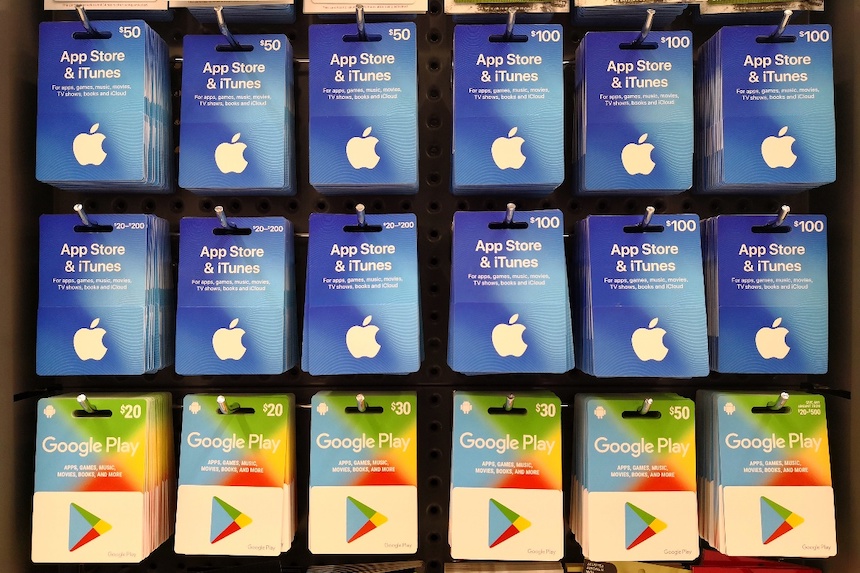Steve Weisman is a lawyer, college professor, author, and one of the country’s leading experts in cybersecurity, identity theft, and scams. See Steve’s other Con Watch articles.
Buying a gift card is easy and a good way to make sure that you give something the recipient will actually use. However, gift cards are also a source of scams. In some scams, criminals steal the value from gift cards you purchase. Other scams involve criminals demanding that victims of extortion use gift cards as the method of payment.
Stealing the Value from a Gift Card
Scammers will go to racks of gift cards in stores and use handheld scanners to read the card’s number and bar code. They then put the card back on the display and periodically check the 800 number associated with the retailer to find out the card’s activation status and balance. Once the card is activated, they can steal the value off the card by either creating a counterfeit card or ordering items online without having the actual card in hand.
When buying a gift card, only purchase cards from behind the customer service desk. If the card is preloaded with a monetary value, always ask for the card to be scanned to show that it is still fully valued. Some retailers have added a PIN on the gift card so that if the card is used online, the user must first scratch off an opaque film to access the PIN. Unfortunately, many purchasers don’t even notice if the film covering the PIN has already been scratched off.
Phony Gift Card Websites
Scammers will set up a website that appears legitimate, inviting you to enter the information from your gift card to check the balance. Victims will soon find that their gift cards are quickly emptied of value. This problem is compounded by the fact that some scammers can use search engines to make their phony gift card registry websites appear at the top of search results.
The best place to find a gift card balance is on the website of the retailer issuing the gift card, which is generally listed on the back of the card. If the retailer’s website has the option for you to register your gift card, you should do so, both for your own convenience and so you can more efficiently report any problems that occur.
Scam Payments Through Gift Cards
Gift cards are a payment method of choice for scammers because they are easily purchased by victims, and payment to the scammer can be accomplished by merely providing card numbers, making the completion of the scam quick and anonymous.
Many different types of scams use gift cards as the method of payment, including the grandparent scam, IRS scams claiming overdue taxes, and tech support scams.
Extortion payments with gift cards have increased dramatically. According to the Federal Trade Commission, in the first nine months of 2015, only 7 percent of scams involved payments through gift cards, while during the first nine months of 2018, 26 percent of scams involved gift card payments.
One reason that gift cards — and iTunes cards in particular — are favored by scammers is that they are easy for victims to obtain, and all that the scammer needs to redeem the card is the 16-digit code on the back, which can be read over the phone.
New Regulations
Wal-Mart, Target, and Best Buy have recently agreed to make changes to their gift card policies after more than a year of negotiations with the attorneys general of New York and Pennsylvania. While the specifics vary from company to company, all of the policy changes result in reducing the amount of money that can be placed on individual gift cards, limiting the total that can be loaded on to multiple gift cards, and restricting the redemption of retail gift cards to buy other gift cards. Finally, and perhaps most importantly, Wal-Mart, Target, and Best Buy have all agreed to enhance the training of their employees to recognize gift card scams and warn their customers.
Remember that the IRS, legitimate tech support companies, lawyers, hospitals, utility companies, and generally any legitimate businesses do not accept gift cards as a form of payment. Whenever you receive a phone call, text message, or email asking for payment for any type of service or debt by gift card, it is a scam.
Become a Saturday Evening Post member and enjoy unlimited access. Subscribe now




Comments
This is excellent information on what has to be one of the dirtiest secrets in all of retail they don’t want you to know until it’s too late, and you can’t get your money back. It happened to some friends of mine at Target several years ago; 2013 or ’14. They got Target cards for Christmas with $20-$50 values, only to find they had no value when it came time to use them.
Call after call to Target’s customer service #; waiting 45 minutes every time, only to be disconnected. Around this same time, we did a real reversal on Target and Wal-Mart realizing Target was no longer “better” or “nicer” than Wal-Mart which has come a long way in the last 10 years. Target’s prices are drastically higher for the much of the same merchandise as Wal-Mart. They’ve closed the gap with Target in most every way, even surpassing them in having more and faster check out lines.*
Ideally gift cards are a nice idea. The person gets a card to put the value on what they want. Fine. The retailers know that the vast majority of them are never used, so for many years they’ve been making a fortune off of people paying them for nothing.
In more recent years with all of the scanning-scamming nightmares this article exposes, these hi-tech cards are trouble best left alone on their steel hooks you just walk by and ignore, before you’re sorry.
(*Wal-Marts in West Hills and Porter Ranch, Ca. referred to above)